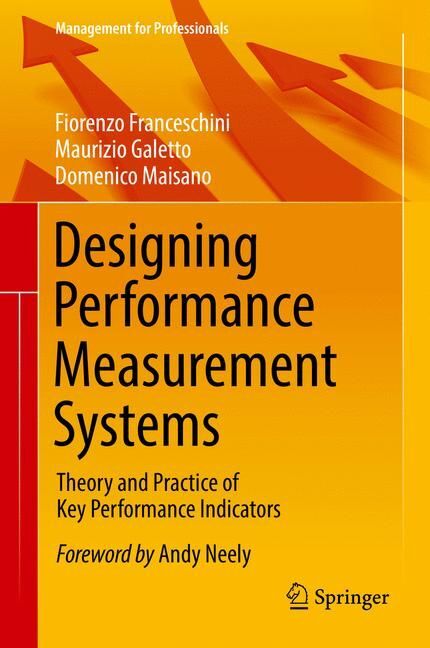Designing Performance Measurement Systems
Given our rapidly changing world, companies are virtually forced to engage in continuous performance monitoring. Though Key Performance Indicators (KPIs) may at times seem to be the real driving force behind social systems, economies and organizations, they can also have far-reaching normative effects, which can modify organizational behavior and influence key decisions - even to the point that organizations themselves tend to become what they measure!
Selecting the right performance indicators is hardly a simple undertaking. This book describes in detail the main characteristics of performance measurement systems and summarizes practical methods for defining KPIs, combining theoretical and practical aspects. These descriptions are supported by a wealth of practical examples. The book is intended for all academics, professionals and consultants involved in the analysis and management of KPIs.
Fiorenzo Franceschini is Full Professor of Quality Engineering at Politecnico di Torino (Italy), Department of Management and Production Engineering (DIGEP). He co-authored seven books and many publications on international journals and conference proceedings. His research interests are in the field of Quality Engineering, Manufacturing Servitization and Performance Measurement Systems. He is member of ASQ, the global leader in quality improvement and standards.
Maurizio Galetto Ph.D. is Full Professor of Quality Engineering at Politecnico di Torino (Italy), Department of Management and Production Engineering (DIGEP). He co-authored four books and many publications on international journals and conference proceedings. His research interests are in the field of Quality Engineering, Process Modeling and Surface Metrology. He is a member of CIRP, the international academy of production engineering.
Domenico Maisano Ph.D. is Associate Professor of Quality Engineering at Politecnico di Torino (Italy), Department of Management and Production Engineering (DIGEP). He co-authored three books and many publications on international journals and conference proceedings. His main scientific interests are in the field of Quality Engineering, Performance Metrics and Industrial Metrology.
1;Foreword;6 2;Preface;8 3;Contents;10 4;1: Quality Management and Process Indicators;13 4.1;1.1 General Concepts;13 4.2;1.2 Quality Management Systems;14 4.3;1.3 The Concept of Process;16 4.3.1;1.3.1 Definition;16 4.3.2;1.3.2 Process Modeling;17 4.3.3;1.3.3 Process Evaluation;17 4.4;1.4 Process Indicators;19 4.4.1;1.4.1 Functions of Indicators;21 4.4.2;1.4.2 Aims and Use of Indicators;22 4.4.3;1.4.3 Terminology;22 4.4.4;1.4.4 Categories of Indicators;23 4.4.5;1.4.5 A General Classification of Indicators;24 4.4.5.1;Initial Indicators (or Structure Indicators);24 4.4.5.2;Intermediate Indicators (or Process Indicators);24 4.4.5.3;Final Indicators (or Result Indicators);25 4.4.6;1.4.6 Comparison of Economic and Process Indicators;25 4.4.6.1;Economic-Financial Indicators;25 4.4.6.2;Process Indicators;27 4.4.7;1.4.7 Indicators and Research: State of the Art;28 4.5;References;29 5;2: Use and Abuse of Indicators;33 5.1;2.1 Introduction;33 5.2;2.2 Human Development Indicator (HDI);34 5.2.1;2.2.1 Life Expectancy Indicator (LEI);35 5.2.2;2.2.2 Educational Attainment Indicator (EAI);35 5.2.3;2.2.3 Gross Domestic Product Indicator (GDPI);36 5.2.4;2.2.4 Calculating the HDI;37 5.2.5;2.2.5 Remarks on the Properties of HDI;37 5.2.5.1;Scale Normalization;37 5.2.5.2;The Effects of Compensation;38 5.2.5.3;Further Remarks on the GDPI;40 5.2.5.4;Statistical Remarks on HDI;41 5.3;2.3 Air Quality Indicators;41 5.3.1;2.3.1 The American Air Quality Indicator (AQI);42 5.3.1.1;AQI Non-monotony;45 5.3.1.2;AQI Non-compensation;45 5.3.1.3;AQI Scale Levels;46 5.3.2;2.3.2 The ATMO Indicator;46 5.3.2.1;ATMO Non-monotony;48 5.3.2.2;ATMO Non-compensation;48 5.3.2.3;ATMO Scale Levels;48 5.3.3;2.3.3 The IQA Indicator;49 5.3.3.1;IQA Non-monotony;52 5.3.3.2;IQA Compensation;52 5.3.3.3;IQA Scale Levels;53 5.3.4;2.3.4 Comments on the Meaning of (sub)Indicators;54 5.3.5;2.3.5 Comparison of Air-Quality Indicators;54 5.4;2.4 The Decathlon Competition;55 5.4.1;2.4.1 The ``Normative´´ Effect of Scoring Indicators;57 5.4.2;2.4.2 Representation and Decision;59 5.5;References;59 6;3: From Measurement Theory to Indicator Theory;61 6.1;3.1 Historical Evolution of the Concept of Measurement;61 6.2;3.2 Stevens´ Theory of Scales of Measurement;63 6.2.1;3.2.1 Nominal Scale;65 6.2.2;3.2.2 Ordinal Scale;66 6.2.3;3.2.3 Interval Scale;66 6.2.4;3.2.4 Ratio Scale;67 6.2.5;3.2.5 Comments on Stevens´ Scale Types;68 6.2.6;3.2.6 Meaningfulness of Statements Concerning Scales;70 6.2.7;3.2.7 Statements Using (Non-)permissible Statistics;75 6.3;3.3 The ``Representation Theory of Measurement´´;77 6.4;3.4 The Formal Concept of Indicator;81 6.4.1;3.4.1 General Definitions;81 6.4.2;3.4.2 The ``Representation Theory of Indicator´´;82 6.5;3.5 Classification of Indicators;84 6.5.1;3.5.1 Objective and Subjective Indicators;84 6.5.2;3.5.2 Basic and Derived Indicators;85 6.6;3.6 The Condition of ``Non-uniqueness´´ for Indicators;85 6.6.1;3.6.1 ``Non-uniqueness´´ for Derived Indicators;85 6.6.2;3.6.2 ``Non-uniqueness´´ for Basic Indicators;90 6.6.3;3.6.3 ``Non-uniqueness´´ for Measurements;92 6.6.4;3.6.4 ``Non-uniqueness´´ when Specializing the Representation Target;92 6.6.5;3.6.5 ``Non-uniqueness´´ for Sets of Indicators;93 6.7;References;94 7;4: Properties of Indicators;96 7.1;4.1 Introduction;96 7.2;4.2 Single and Aggregated Performance;98 7.3;4.3 The Concept of Indicator;98 7.4;4.4 Further Considerations on the Classification of Indicators;101 7.4.1;4.4.1 The Representational Approach for Derived Indicators;103 7.5;4.5 Brief Outline of the Properties of Indicators in Literature;104 7.6;4.6 Taxonomy of the Properties of Indicators;106 7.6.1;4.6.1 Properties of Single Indicators;107 7.6.1.1;Consistency with Representation Target;107 7.6.1.2;Meaningfulness of Statements;107 7.6.1.3;Level of Detail;114 7.6.1.4;Counter-Productivity;116 7.6.1.5;Economic Impact;118 7.6.1.6;Simplicity of Use;118 7.6.2;4.6.2 Properties of Sets of Indicators;119 7.6.2.1;Exhaustiveness;120 7.6.2.2;Further Considerations on the
Franceschini, Fiorenzo
Galetto, Maurizio
Maisano, Domenico
| ISBN | 9783030011925 |
|---|---|
| Artikelnummer | 9783030011925 |
| Medientyp | E-Book - PDF |
| Copyrightjahr | 2018 |
| Verlag | Springer-Verlag |
| Umfang | 220 Seiten |
| Sprache | Englisch |
| Kopierschutz | Digitales Wasserzeichen |






